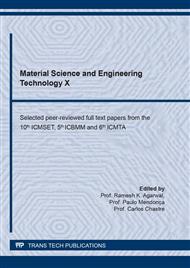[1]
A.M. Diab, A.E.M.A. Elmoaty, M.R.T. Eldin. Slant shear bond strength between self-compacting concrete and old concrete, Constr. Build. Mater. 130 (2017) 73-82.
DOI: 10.1016/j.conbuildmat.2016.11.023
Google Scholar
[2]
Renyuan Qin, Huali Hao, Theodoros Rousakis. Effect of shrinkage reducing admixture on new-to-old concrete interface. 167(2019): 346-355.
DOI: 10.1016/j.compositesb.2018.11.087
Google Scholar
[3]
European Committee for Standardization. Eurocode No. 2: design of concrete structure spart 1-1: general rules and rules for building, London: British Standards Institution. (2004).
Google Scholar
[4]
Ministry of Housing and Urban-Rural Development of the People's Republic of China. Technical specification for precast concrete structures: JGJ1-2014, Beijing: China Architecture & Building Press. (1997).
Google Scholar
[5]
The International Federation for Structural Concrete(fib). Model code 2010, Lausanne: The International Federation for Structural Concrete. (2012).
Google Scholar
[6]
Y. He, X. Zhang, R.D. Hooton, X. Zhang, Effects of interface roughness and interface adhesion on new-to-old concrete bonding, Constr. Build. Mater. 151(2017) 582-590.
DOI: 10.1016/j.conbuildmat.2017.05.049
Google Scholar
[7]
E.N.B.S. Julio, F.A.B. Branco, V.D. Silva, J.F. Lourenço, Influence of added concrete compressive strength on adhesion to an existing concrete substrate, Build. Environ. 41 (12) (2006) 1934-1939.
DOI: 10.1016/j.buildenv.2005.06.023
Google Scholar
[8]
P.M.D. Santos, E.N.B.S. Julio, V.D. Silva, Correlation between concrete-to-concrete bond strength and the roughness of the substrate surface, Constr. Build. Mater. 21(8)(2007)1688-1695.
DOI: 10.1016/j.conbuildmat.2006.05.044
Google Scholar
[9]
Yang Zhang, Yanping Zhu, Shaoqin Qu, Aditya Kumar, Xudong Shao. Improvement of flexural and tensile strength of layered-casting UHPC with aligned steel fibers, Construction and Building Materials, (251)(2020).
DOI: 10.1016/j.conbuildmat.2020.118893
Google Scholar
[10]
Xiaojing Li, Yaoyao Zhang, Chong Shi. Experimental and numerical study on tensile strength and failure pattern of high-performance steel fiber reinforced concrete under dynamic splitting tension, Construction and Building Materials, 259( 2020).
DOI: 10.1016/j.conbuildmat.2020.119796
Google Scholar
[11]
Santos, P., Julio, E.N.B.S., Silva, V.T.D. Correlation between concrete-to-concrete bond strength and the roughness of the substrate surface, Constr. Build. Mater. 21(2007)1688-1695.
DOI: 10.1016/j.conbuildmat.2006.05.044
Google Scholar
[12]
Shen, Y. Wang, Y., Yang, Y., Sun, Q., Luo, T., Zhang, H. Influence of surface roughness and hydrophilicity on bonding strength of concrete-rock interface, Constr. Build. Mater. 213(2019)156-166.
DOI: 10.1016/j.conbuildmat.2019.04.078
Google Scholar
[13]
Tayeh, B.A.; Abu-Bakar, B.H.; Megat-Johari, M.A.; Ratnam, M.M. The relationship between substrate roughness parameters and bond strength of ultrahigh-performance fiber concrete. J. Adhes. Sci. Technol. 27(2013)1790-1810.
DOI: 10.1080/01694243.2012.761543
Google Scholar
[14]
Cheng, M., Ma, J. Experimental Study on Shear Behavior of the Interface between New and Old Concrete with Reinforced, KSCE J. Civ. Eng. 22(2018)1882-1888.
DOI: 10.1007/s12205-017-2007-6
Google Scholar
[15]
R. Sen, Developments in the durability of FRP-concrete bond, Constr. Build. Mater. 78 (2015) 112-125.
Google Scholar


